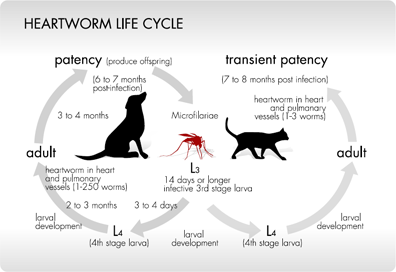Heartworm Disease in Cats
Heartworm disease is caused by a roundworm (nematode) parasite called Dirofilaria immitus, which is carried by mosquitoes. It is more common in warm, humid areas but can be seen anywhere, especially as animals are often moved around geographically.
Life Cycle of Heartworms
Animals cannot directly infect each other with heartworm; a mosquito must carry the parasite from one dog to another.

The heartworm life cycle is as follows:
- Female worms in an infected animal lay eggs, which hatch into early larvae, called microfilaria, in the bloodstream.
- A mosquito bites the animal and drinks the microfilaria with the blood.
- The microfilaria become mature larvae within the mosquito.
- When the mosquito bites the next animal, these larvae are injected into the body. The larvae mature further within the bloodstream, and as adults, they settle into the heart and the pulmonary vessels (the arteries and veins that carry blood between the heart and lungs).
- The adult worms can then mate and lay eggs, continuing the cycle.
The entire process, from an uninfected cat being bitten by an infected mosquito to being able to infect another mosquito with microfilaria, takes about 7 to 9 months.
Clinical Signs of Heartworm Disease in Cats
Cats have a lower risk of being infected with heartworm disease than dogs, and if they are infected, tend to have only 1 to 3 worms (dogs can be infected with 1 to 250 worms). Regardless, cats seem to develop severe illness even with the low number of worms. The signs include wheezing, vomiting, gagging, lethargy, and weight loss and can be confused with other conditions, such as asthma.
Diagnosis of Heartworm Disease in Cats
There are two main ways to diagnose heartworm infection in cats:
- One method is to look for actual microfilaria in the bloodstream. However, if a cat is only infected with male worms, immature worms, or a single unfertilized female, there won't be any larvae.
- The more common method is to look for a heartworm substance called an antigen in the bloodstream. This is not dependent on reproductive capabilities of the worms, but it does require them to be mature, which can take an average of 7 months. This blood test can be sent to a laboratory or is often done as a quick in-house test at the veterinary clinic.
Imaging studies, such as x-rays or echocardiography, can also find evidence of heartworm infection in cats, but these are not routine screening tests.
Treatment of Heartworm Disease in Cats
Treatment options for heartworm in cats are limited. While injections to kill mature heartworms are usually given to dogs, they cannot be given to cats. At this point, the only options are supportive care to minimize clinical signs and a heartworm preventative to clear any larvae in the bloodstream and prevent re-infection.
Prevention of Feline Heartworm Disease
There are a number of heartworm preventatives available for cats. These include daily or monthly tablets and monthly spot-on treatments. These preventatives are often part of a multipurpose product that also contains other dewormers, flea control, and/or mosquito repellents, and your veterinarian can help you choose the most appropriate one for your cat. The goal of the preventatives is to stop any larvae in the bloodstream from maturing into adult worms. Cats do not need to be tested prior to starting preventatives, but you should consult with your veterinarian before starting a heartworm preventative program.
Further Reading
For more information, check out The American Heartworm Society.
You May Also Like These Articles:
Flame Retardants and Hyperthyroidism in Cats
Saddle Thrombus: Aortic Blood Clots in Cats
Notice: Ask-a-Vet is an affiliated service for those who wish to speak with a veterinary professional about their pet's specific condition. Initially, a bot will ask questions to determine the general nature of your concern. Then, you will be transferred to a human. There is a charge for the service if you choose to connect to a veterinarian. Ask-a-Vet is not manned by the staff or owners of CatHealth.com, and the advice given should not delay or replace a visit to your veterinarian.






